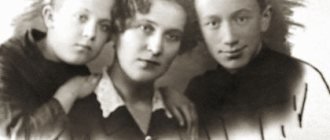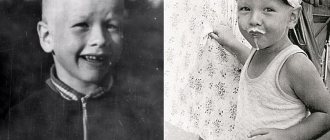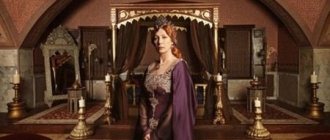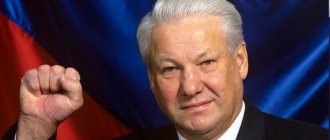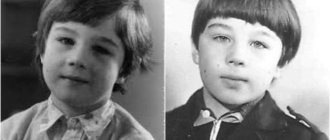Childhood and youth
Simon Petlyura was born in Poltava in 1879 into a large family. His father worked as a cab driver, the Petliurs lived poorly. In his youth, the young man prepared to become a priest, first receiving his primary education at a church school, then studying at the city seminary. He was expelled from his final year for his passion for political journalism. Self-taught Petliura wrote hundreds of fascinating articles on various topics in his short life.
Simon Petliura in his youth
At the age of 21, the young man joined the Revolutionary Ukrainian Party, in 1903 he moved to Lviv, working as a journalist in the publications “Slovo”, “Peasant”, “Good News”. The frequent change of publishing houses is associated with the revolutionary spirit of the young man; moreover, his views often became too radical for liberal newspapers and magazines.
In 1908, Simon managed to move to Moscow, rent a room near the city university - he sometimes went there as a volunteer. Petlyura makes a living from journalism: he writes articles and writes about the history of Little Russia in the famous magazine “Slovo”.
Simon Petliura in Kamenets-Podolsk
In his free time from work, he studies the history of his native country: his erudition allows him to enter the circle of Little Russian intellectuals, where he meets the historian Mikhail Grushevsky. His social circle allowed the provincial Petlyura, despite the lack of higher education, to become an educated person. It was Grushevsky who helped Simon take the first steps towards fleeting dictatorial glory, initiating him into the Masonic lodge.
Biography
Born into a petty-bourgeois family in Poltava. He studied at the Poltava Theological Seminary. In 1900 he joined the Revolutionary Ukrainian Party. He worked as a journalist, adhered to left-wing nationalist views, and was one of the founders and leaders of the Ukrainian Social Democratic Labor Party.
During the First World War he worked in the All-Russian Union of Zemstvos and Cities.
, created in 1914 to help the government of the Russian Empire organize supplies for the army. After the proclamation of the Ukrainian People's Republic, he became the military secretary of the new government, but soon resigned. Participated in battles against the Red Army.
After the establishment of the dictatorship of Hetman Skoropadsky (Ukrainian State) he was in opposition to the new regime. In December 1917, from volunteers, mainly foremen and Cossacks from Kyiv military schools, he formed the military unit of the Gaydamat Kosh, becoming its chieftain. In November 1918 he raised an uprising against Skoropadsky, and on December 14 his militia occupied Kyiv. The Ukrainian People's Republic was restored, and Vladimir Vinnychenko became its head.
On February 10, 1919, after the resignation of Vinnychenko, he actually became the sole dictator of Ukraine. In the spring of the same year, trying to stop the Red Army's seizure of the entire territory of Ukraine, he reorganized the UPR army. He tried to negotiate with the White Guard command of the AFSR on joint actions against the Bolsheviks, but was unsuccessful.
On April 21, 1920, after the Soviet-Polish war, which ended in the complete defeat of the Western Ukrainian People's Republic, Symon Petliura, on behalf of the UPR, agreed with Poland on the border between the states along the Zbruch River, thereby recognizing the entry of Galicia into Poland on the basis of autonomy.
At the first stage of the Soviet-Polish war, Petlyura was an enemy of Poland. Later, the situation changed and on April 25, 1920, Petliura and Pilsudski agreed on a military alliance, subject to the restoration of Ukrainian independence. After this, the UPR army participated in the war on the side of the Poles. After the end of the war and the signing of the Riga Peace Treaty, Petliura emigrated to Poland. In 1923, the USSR demanded Petliura's extradition, so he moved to Hungary, then Austria, Switzerland and finally France.
Politics and war
During the First World War, Petliura served as deputy commissioner of the All-Russian Union of Zemstvos and Cities, dealing with supplies to the Russian army. There, for the first time, civilian Simon tried on a military uniform: paramilitary activities brought him closer to the front and allowed him to conduct political propaganda in the Ukrainian ranks.
Simon Petlyura in military uniform in 1915
The revolution of 1917 found Simon in Belarus, on the Western Front. Petlyura manages to get into the whirlpool of events related to the national liberation movement in Ukraine, the man becomes one of the leading figures in Ukrainian politics. In June, Simon was appointed secretary of military affairs of the first Ukrainian government, headed by Vladimir Vinnychenko.
The position was soon abolished, but Petliura continues to form regiments and battalions on a voluntary basis, despite the fact that Vinnychenko has repeatedly stated the futility of creating a Ukrainian army. In December 1918, troops formed by Petliura occupied Kyiv. On the 15th he took power, but his reign lasted 45 days. On the night of February 2, Simon fled the country.
Portrait of Simon Petliura
Once in power, Petliura had virtually no experience of actually leading people. His policy in recent years was aimed only at seizing power, then he hoped for help from European rulers. But Paris and London had no time for Kyiv in those days; they divided the territories after the end of the First World War. After welcoming speeches and banquets, Simon was in confusion: how to govern the country?
One day the ruler proclaimed the capitalization of commercial banks, and a couple of days later he canceled the decisions. During his short government, he emptied the treasury in the hope of financial and military European assistance. Meanwhile, the anarchists were approaching Kyiv, and the Red Army was advancing from the east. Fearing dictatorship, the cornered ruler fled Kyiv and “sank to the bottom” for several years.
Simon Petliura
In March 1921, after the Treaty of Riga was signed, Petliura immigrated to Poland. In 1923, the Soviet Union demanded that Polish officials extradite Petlyura, so Simon fled first to Hungary, from there to Austria, then to Switzerland, and in 1924 he ended up in France.
“Petliura is an idealist without any scope”
May 2012 marked the 133rd anniversary of the birth of Symon Petlyura. There is hardly a more controversial personality in the history of Ukraine. Who was he? Who is he - a paid agent of the Western powers or an ardent patriot, a talented politician, or an ordinary bandit. Some historians characterize him as an incorrigible adventurer and careerist, others as a traitor to national interests, and still others as the unofficial head of the criminal circles of Ukraine. It is unlikely that we will ever know all the answers. History carefully guards its secrets. However, let's at least lift the veil today.
Simon Petliura had strong leadership qualities and an extraordinary mind, was always interested in issues of art, loved to speak on topics about literature and drama in Ukraine, and played the violin quite well. Following the advice of his parents, he entered the Poltava Theological Seminary and studied there until 1901. He was unable to complete it because he was expelled for poor academic performance and participation in meetings of the Revolutionary Ukrainian Party. Young Petlyura came to Kuban in search of work in 1902. His dream was to become a teacher, but his reputation as a revolutionary and troublemaker closes all doors in front of him. He earns his living by publishing in local newspapers and magazines. His study of Kuban, published in the Literary and Scientific Bulletin, is known. Hiding from the authorities, in 1902 Simon moved to Yekaterinodar, where he was arrested in December 1903. After his release in March 1904, he entered the university in Lvov. He returned to Russia in 1905 after an amnesty. Until 1907, as part of an expedition, he explored the steppe regions of the Kuban, worked as a teacher, accountant, and editor of the Slovo newspaper. Due to the threat of another arrest, Petliura leaves for Moscow. In the period from 1907 to 1912, he edited the magazine “Ukrainian Life”, got married, and had a daughter, Lesya.
With the outbreak of the First World War, Petliura's life changed dramatically. First, he gets a job in a charity organization that provides consumer services to the tsarist army. At the end of May 1917, the Central Rada of Ukraine held elections for the first military congress of Ukrainians. Military uniform and education give Petlyura advantages, and he becomes one of the delegates. Later, with a reputation as a social democrat, he becomes a member of the presidium. After the formation of the government of the Central Rada, Simon receives the post of Minister of Military Affairs. The reasons for such a rapid career rise can be explained by the fact that in Ukraine there was a catastrophic shortage of literate adults. In addition, Petliura was delegated from the front. His personal qualities, negotiation skills and experience in military affairs were of no importance then.
In the first days, Petlyura decides to defend an alliance with Russia. At the same time, he advocates war with Germany and Austria. The provisional government in Russia is completely satisfied with this state of affairs. “Ukrainized” military units began to be created. Petliura spent most of his time in a train carriage traveling through the western regions of Ukraine. A colleague wrote about him:
“Petlyura is an idealist without any scope. But what I liked was a certain feeling of love for everything Ukrainian. This feeling was genuine and without any personal utilitarian goals. It was clear that people were working not under pressure, but with passion.”
However, after the October Socialist Revolution, the new Soviet government concluded a Peace Decree with Germany. The Eastern Front collapsed, which worried the Entente countries. Their only hope was the Central Rada. Simon Petliura accurately sensed the wind of change and, as Minister of Military Affairs, began negotiations with Western diplomats in Kyiv. But the Rada considered it more promising to unite with Germany than to rely on the promises of the Entente countries and the United States. After this, Petlyura only had to resign.
Power changes people. Petlyura felt her taste and did not want to part with her. Therefore, he goes straight to the Poltava region in order, with the support of the friendly local ataman Volokh, to organize his own Haidamak military detachment. Its core consisted of Cossacks and foremen from Kyiv military schools. In the winter of 1918, Petlyura comes to Kyiv to the aid of the Central Rada, which, under pressure from the advancing Red Army, is rapidly losing supporters. The Petliurists brutally suppress worker uprisings in the city. In those days they killed about 1,500 people. Two days later, the Central Rada fled the city. The Petlyura detachment covered her retreat to Zhitomir. Here, on January 27, 1918, they united with German-Austro-Hungarian troops, launching an attack on Kyiv. Thus, Petliura, by coincidence, was associated with the seizure of Ukraine by German-Austrian troops. He wrote in 1925:
“We just need to remember one thing: if the Central Rada had not invited the Germans, they would have come to us themselves. They knew well that the front no longer existed, and in Ukraine there was also no large, disciplined army, no firm power, then their road to us would be free: no one would stop them.”
The occupiers created the Ukrainian State under the leadership of Hetman Skoropadsky. Petlyura gained the position of chairman of the All-Ukrainian Union of Zemstvos, but was hostile to the new regime. In August 1918, Petliura was arrested. After his release, he was able to reach a nearby detachment of Sich riflemen. That same night, in his own name, he wrote an appeal to the entire people of Ukraine calling on them to start an uprising. Having spread throughout the country, the liberation movement immediately ceased to be controllable, resulting in the personal actions of individual bandit atamans. Pogroms and destruction took place throughout Ukraine. Some gangs committed special atrocities, shooting their victims without trial. The real extermination of the Jewish population began. A huge number of people were killed, hundreds of cities and villages were burned to the ground. The lawlessness in Trostinets and the Uman massacre, the atrocities in the town of Slovechno and the Novomirgorod massacre, the pogroms in Smela, Radomysl, and Elisavetgrad will forever remain in history. According to eyewitnesses, Petlyura did not approve of anti-Semitism, but did not intend to stop it. The atamans, the commanders of the detachments, acted at their own discretion throughout Ukraine. Petliura gave them complete freedom of action and diligently ignored the crimes they committed.
In the winter of 1918, the German occupation ended. Petlyura single-handedly led the troops of the Ukrainian Directory. In January 1919, in order to increase its authority in the eyes of the Entente countries, the Directory officially declared war on Russia. Allied troops landed in Odessa, but were in no hurry to provide military assistance to Ukraine. And the war flared up more and more. In February 1919, the Directory left Kyiv. In response to a desperate request for support, the head of the Allied forces, Colonel A. Freudenberg, asked to remove a number of people from leadership. Petlyura was also included in this list with the short wording “for banditry.” The Directory's leadership only partially complied with their request, limiting his powers. At a meeting in Proskurov on March 14, 1919, Petlyura stubbornly defended the decision to continue negotiations with the Entente. He also managed to prevent a long-pending peace treaty with Russia. The Entente set a huge price for military assistance. The Directory was supposed to form an army of 300 thousand people in three months and place it under French command. Also, all finances of Ukraine came under the control of the French. These plans were not destined to come true. Without waiting for confirmation of the peace pact, the Red Army again launched an offensive and pushed the Ukrainian army into Poland.
After negotiations with the Entente reached a dead end, and their troops were expelled by the Red Army, Petliura began negotiations with the Poles. Now his obsession was to liberate Ukraine from Soviet troops with the support of Poland. On April 21, 1919, Petliura signed the Warsaw Agreement, according to which Western Volyn and Eastern Galicia were transferred to Poland. After this, the liberation army set out on a campaign. At the same time, Petlyura makes an attempt to come to an agreement with Denikin, who was also moving towards Kyiv at the head of the Volunteer Army. By coincidence, on August 31, an armed clash occurred between Denikin’s and Petliurists over an insult to Denikin’s banner, which put an end to the relationship that had begun. Petliura was betrayed by his own headquarters, after which he had to flee to Warsaw. And on June 12, 1920, Kyiv was again occupied by the Red Army
In 1920, Russia forced Poland to sign the Treaty of Riga, and Petliura moved to Baron Wrangel. But the joint November offensive of the White Guard units and Petliura troops did not lead to success. When Wrangel's troops were defeated in Crimea, the Petliurists laid down their arms. In 1923, the Soviets demanded that Warsaw hand over Petliura to them, so he and like-minded people fled to Hungary, then to Vienna and Geneva. Finally, in October 1924, he settled in Paris, where on May 25, 1926, he was killed by a pistol shot by a certain Samuel Schwartzbard. According to one version, the killer was an anarchist, a friend of Nestor Makhno. According to another version, Schwartzbard took revenge for his relatives killed in Ukraine. He was later acquitted.
There is no clear assessment of the actions of the disgraced chieftain. In Dnepropetrovsk there is a plaque erected in memory of the victims of Simon Petlyura and his soldiers. And on May 16, 2005, in Ukraine, the president signed a decree on perpetuating the memory of the ataman and erecting monuments to him. But today it is known that there are still no monuments to him.
Sources: https://www.vitrenko.org/news.php?lang=1&part_id=25&subpart_id=111&article_id=1213&year_id=2007&month_id=05 https://voenhronika.ru/publ/grazhdanskaja_vojna_v_rossii/pjat_smertej_simona_petljury_rossija_2008_god/ 7-1-0-1336 https://hrono.ru/biograf/bio_p/petljura_s.php https://myblogjoker777.blogspot.com/2011/05/25-25.html https://www.people.su/131424 https://www .e-reading.org.ua/chapter.php/1004551/34/Sever_Aleksandr_-_Russko-ukrainskie_voyny.html
Personal life
In 1908, in Moscow, at a meeting of the Ukrainian community, Simon met a young student, Olga Belskaya. Common views and origins brought the young people together; Petliura tried to visit Moscow as often as possible. In 1910 they began to live in a civil marriage, five years later Olga and Simon officially signed and got married.
Simon Petlyura and his wife Olga
In 1911, the student realized that she was expecting a child. Olga's parents, strict people of conservative views, learned about the birth of their granddaughter only a few months later - the girl was so afraid of the reaction of her relatives. Olya went to Kyiv to give birth; having grown stronger after childbirth, she returned to Moscow, to Simon. From then until the death of Petliura, the couple did not part.
His wife Olga is probably Petlyura’s only woman. He was modest and embarrassed to communicate with ladies. Simon's further biography shows that the man is monogamous, and politics became the meaning of life for him.
Simon Petliura with his wife and daughter
Lesya Petliura inherited her father’s literary talent and became a poet. Her life was short: at the age of 30, in 1941, she died of tuberculosis in Nazi-occupied Paris. Lesya had no children. Simon's sister and nephews, who remained in Ukraine, were repressed and executed in 1937, rehabilitated in 1989.
Death
Petlyura died on May 25, 1926, the cause of death was seven bullet wounds. The murder should have happened 15 days earlier. On May 10, Simon celebrated his birthday in a restaurant and did not even realize that at the next table the bandit Nestor Makhno was convincing NKVD agent Samuil Schwartzbard not to touch Petliura. There were times when Simon saved Nestor from his own “colleagues” who suspected the leader of being corrupt, and he tried to repay the favor.
Monument to Simon Petliura
Makhno was only able to delay the reprisal against the head of the UPR government: on May 25, Schwartzbard shot Petlyura in the doorway of a bookstore on Racine Street. The criminal was immediately detained by the police; he did not try to hide or deny, saying that he dealt with Simon out of revenge because of the Jewish pogroms he organized in 1918-1920. The Ukrainian politician was buried in the Parisian cemetery de Montparnasse.
The murderer was acquitted by the jury at trial. Only in 1954, former KNB employee Pyotr Deryabin testified to Congress that the murder was a contract killing, initiated by the NKVD. His wife Olga lived to see this news and died in 1959.
Symon Petliura's grave
In 2020, Ukrainian director Oles Yanchuk released the documentary drama “The Secret Diary of Symon Petlyura,” which tells about the last stage of the politician’s life and his death. The director and producer set out to tell the younger generation the truth about the events of that time; the film was financed by the state.
Murder of Petliura
File:Petlura gravestone.jpg Petlura's grave at the Montparnasse cemetery in Paris
Petliura was killed on May 25, 1926 in Paris by S. Schwartzbard, a native of the city of Izmail, who later moved to the town of Balta, where at the beginning of the 20th century Jews made up 79.3% of the total population. Samuel Schwartzbard called himself an anarchist. He knew Nestor Makhno[1], with whom, on the eve of Petliura’s assassination, he allegedly tried to share plans. According to Makhno’s own memoirs, he tried to dissuade Schwartzbard from killing and even warn Petliura, but in vain. Later, Nestor Makhno spoke at the trial in the Schwarzbard case and testified in favor of Petlyura, denying, in particular, the anti-Semitism of the Ukrainian leader.
Schwarzbard himself, in his first confessions to the French police, said that he had heard about brutal pogroms from fellow believers whom he met in 1917 on the road from St. Petersburg to Odessa. This is evidenced by publications in the French press of that time: in the newspapers Eco de Paris, Paris-Midi and others. Later, Schwarzbard's lawyer, Henri Thores, a communist from a young age, put forward a different version of the defense: about 15 Schwarzbard relatives, including parents, allegedly killed in Ukraine by Petliurists during the Jewish pogroms.
Petliura’s associates and relatives presented more than 200 documents at the trial, testifying that Petliura personally not only never encouraged anti-Semitism, but also harshly suppressed its manifestations in his army. The investigation also did not take into account the statements of witnesses, and in particular Elijah Dobkovsky, who gave public testimony about the participation in the case of the Russian Mikhail Volodin, according to some sources, an agent of the GPU (A. Yakovlev’s book “The Parisian Tragedy”). Volodin actively collected information about the chieftain, was personally acquainted with Schwartzbard and, according to Dobkovsky, helped him prepare the murder.
However, Schwarzbard was completely acquitted by a French jury.
Simon Petlyura tried as best he could to stop the pogroms and cruelly punished those of his soldiers who took part in them.
So, when on March 4, 1919, Petliura’s “ataman” Semesenko, 22 years old, gave his “Zaporozhye Brigade”, stationed near Proskurov, the order to exterminate the entire Jewish population in the city, on March 20, 1920, on Petliura’s orders, he was shot. On the eve of the pogrom, Semesenko declared that there would be no peace in the country as long as there was at least one Jew left there. On March 5, the entire “brigade” of 500 people, divided into three detachments, led by officers, entered the city and began beating Jews. They broke into houses and often massacred entire families. Over the course of the whole day, from morning to evening, up to three thousand people were killed, including women and children. They killed exclusively with cold steel. The only person killed by a bullet was an Orthodox priest who, with a cross in his hands, tried to stop the fanatics. A few days later, Semesenko imposed an indemnity of 500 thousand rubles on the city and, having received it, thanked in an order the “Ukrainian citizens of Proskurov” for the support they provided to the “People’s Army”. [2] See also: Proskurov pogrom
There is also a version that the murder of Symon Petlyura was allegedly prepared thanks to the activities of the Masonic lodge, because Symon Petlyura, a member of the Masonic community, and in the future the creator of the Great Ukrainian Lodge (Ukrainian), opposed orders with impulsive statements and a completely different idea about the independence of Ukraine, which the assessors of the Masonic Lodge in Paris did not like. [1] After the May coup in Poland organized by the Freemasons, Petliura also threatened to expose the Freemasons if they did not help him take power in Ukraine.[3]
Memory
- May 16, 2005 - A decree was signed to perpetuate the memory of Symon Petlyura, as well as to install monuments in Kyiv and other cities of Ukraine, and to name individual military units after him;
- streets in the following cities are named in honor of Petlyura: Lviv, Rivne, Ternopil, Ivano-Frankivsk, Shepetivka;
- February 11, 2008 - The Kyiv City Administration Commission on Names and Memorial Signs decided to rename one of the streets in Kyiv to Simon Petlyura Street;
Monument to Simon Petliura in Vinnitsa
- June 16, 2009 - The Kiev City Council Commission on local self-government, regional, international relations and information policy recommended that the Kiev City Council rename Comintern Street in the Shevchenkovsky district of the capital to Simon Petlyura Street;
- May 29, 2009 - The National Bank of Ukraine introduced into circulation a commemorative coin with a face value of 2 hryvnia “Simon Petlyura”;
- October 14, 2020 – a monument to Simon Petlyura was unveiled in Vinnitsa, a postage stamp with his photo was issued.

